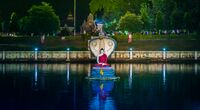Muchalinda
| Author:Laxman Burdak, IFS (R) |

Muchalinda (मूचालिंडा) is the name of a Naga King who protected the Gautama Buddha from the elements after his enlightenment.[1] Muchalinda was Naga of a tank on the south side of the Bodhi tree at Uruvilwa, the present Bauddha Gaya. [2]
Variants
Legend
It is said that four weeks after Gautama Buddha began meditating under the Bodhi tree, the heavens darkened for seven days, and a prodigious rain descended. However, the mighty King of Nagas, Mucalinda, came from beneath the earth and protected with his hood the one who is the source of all protection.
During the sixth week Buddha sat by the Lake Muchalinda, where a Naga of the same name sheltered him from storms of rain.[3]
When the great storm had cleared, the serpent king assumed his human form, bowed before the Buddha, and returned in joy to his palace.
The subject of Buddha meditating under the protection of Mucalinda is very common in Lao Buddhist art. A particularly striking gigantic modern rendition is present in Bunleua Sulilat's sculpture park Sala Keoku.
In Mahavansha
Mahavansa/Chapter 2 mentions about the Race of Mahasammata: Sprung of the race of king Mahasammata was the Great Sage. For in the beginning of this age of the world there was a king named Mahüsammata, and (the kings) Roja and Vararoja, and the two Kalyanakas, Uposatha and Mandhata and the two, Caraka and Upacara, and Cetiya and Mucala and he who bore the name Mahamucala, Mucalinda and Sagara and he who bore the name Sagaradeva; Bharata and Angirasa and Ruci and also Suruci, Patäpa and Mahapatapa and the two Panadas likewise, Sudassana and Neru, two and two; also Accima. His sons and grandsons, these twenty-eight princes whose lifetime of immeasurably (long), dwelt in Kusavati, Rajagaha, and Mithila.
History
Sir Alexander Cunningham[4] writes that....It would appear, however, that the Buddhists must have adopted and altered the legend to do honour to their great teacher, for Hwen Thsang records that out- [p.361]: side the town there was a Naga-hrada, or " serpent tank," near which Buddha had preached the law for seven days in favour of the serpent king, and that the spot was marked by a stupa of King Asoka[5] Now, as the only existing stupa at this place is called Chattr, I infer that the Buddhist legend represented the Naga king after his conversion as forming a canopy over Buddha with his expanded hood. I think, also, that the stupa erected on the spot where the conversion took place would naturally have been called Ahi Chhatra, or the " serpent canopy." A similar story is told at Buddha Gaya of the Naga King Muchalinda, who, with his expanded hood, sheltered Buddha from the shower of rain produced by the malignant demon Mara.
मूचालिंडा झील
बुद्ध ने छठा सप्तााह महाबोधि मंदिर के दायीं ओर स्थित मूचालिंडा झील के नजदीक व्यतीत किया था. यह क्षील चारों तरफ से वृक्षों से घिरा हुआ है. इस क्षील के मध्य में बुद्ध की मूर्त्ति स्थापित है. इस मूर्त्ति में एक विशाल सांप बुद्ध की रक्षा कर रहा है. इस मूर्त्ति के संबंध में एक दंतकथा प्रचलित है. इस कथा के अनुसार बुद्ध प्रार्थना में इतने तल्लीन थे कि उन्हें आंधी आने का ध्यान नहीं रहा. बुद्ध जब मूसलाधार बारिश में फंस गए तो नाग राजा मूचालिंडा अपने निवास से बाहर आया और बुद्ध की रक्षा की.[6]
External links
References
- ↑ Thanissaro, Bhikkhu. "Muccalinda Sutta: About Muccalinda".
- ↑ List of Naga Rulers Alphabetical
- ↑ Myths and Legends of the Hindus & Buddhists/CHAPTER V,p.272
- ↑ The Ancient Geography of India/Ahichhatra, p.360-361
- ↑ Julien's 'Hiouen Thsang,' ii, 235.
- ↑ https://www.jatland.com/home/User:Lrburdak/My_Tours/Tour_of_North_East_India

